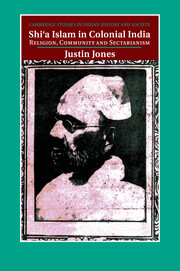Book contents
- Frontmatter
- Contents
- Figures and maps
- Preface and acknowledgements
- Frequently used abbreviations
- Note on transliteration
- Select glossary of terms
- Introduction
- 1 Madrasas, mujtahids and missionaries
- 2 Mosques, majalis and Muharram
- 3 Anjumans, endowments and Indian Shi‘ism
- 4 Aligarh, jihad and pan-Islam
- 5 The tabarra agitation and Shi‘a–Sunni conflicts in late colonial India
- Conclusion and epilogue Shi‘ism and sectarianism in modern South Asia
- Appendix Select Shi‘a ‘ulama of colonial India
- Select bibliography
- Index
3 - Anjumans, endowments and Indian Shi‘ism
The making of Shi‘a society
Published online by Cambridge University Press: 05 November 2011
- Frontmatter
- Contents
- Figures and maps
- Preface and acknowledgements
- Frequently used abbreviations
- Note on transliteration
- Select glossary of terms
- Introduction
- 1 Madrasas, mujtahids and missionaries
- 2 Mosques, majalis and Muharram
- 3 Anjumans, endowments and Indian Shi‘ism
- 4 Aligarh, jihad and pan-Islam
- 5 The tabarra agitation and Shi‘a–Sunni conflicts in late colonial India
- Conclusion and epilogue Shi‘ism and sectarianism in modern South Asia
- Appendix Select Shi‘a ‘ulama of colonial India
- Select bibliography
- Index
Summary
While ‘Abd ul-Halim Sharar’s ever-influential account of Nawabi Lucknow commended the city for its seeming promotion of cross-community accommodation and interaction between Shi‘a and Sunni residents, his view of the colonial city in which he resided was somewhat different. ‘The Shi‘a’, he wrote, ‘maintain a separateness (judagana) in their habits and customs’; instead of attempting to ‘unite into one fraternity’ with other Muslims, they ‘prefer to remain separate and exclusive (juda-va-mumtaz)’. As previous chapters of this book have shown, this separateness was manifested in aspects of religious change: the sectionalization of Shi‘a and Sunni madrasa education, clerical mobilization, majlis congregations and Muharram participation, for example. It was also communicated through the new adoption of particular cultural norms and identifiers. The Shi‘a, allegedly, began after the annexation of Awadh to use the address ‘Salam-un ‘Alaikum’ rather than the more traditional ‘As-Salam ‘Alaikum’, in order to distinguish themselves from Sunnis. Equally, when the Turkish cap was popularized among many young sharif Muslims by Sayyid Ahmad Khan and other Aligarh reformists from the 1870s onwards, many Shi‘a adopted the Persian kulah cap as a retort. It also came, with the help of the municipal administration in Lucknow, through the establishment of separate Shi‘a and Sunni graveyards from 1871.
This chapter expands analysis of this Shi‘a judagana from the assertion of religious and cultural distinctiveness to the appearance of active social and political demands to keep ‘separate’ (‘alehda). Departing the focus on religious change taken in earlier chapters, this chapter switches to the organizational, financial and linguistic apparatus on which a Shi‘a community was constructed in colonial India, with an examination of a number of newly founded Shi‘a organizations and charitable campaigns. The first section discusses the creation of a number of Shi‘a anjuman: public associations, charities and societies emerging around the turn of the twentieth century. This is conducted primarily through a discussion of the All India Shi‘a Conference, formed in 1907. The most significant and best documented of the various Shi‘a anjuman of the period, it became something of an umbrella for a wider network of interlinked associations. The chapter then discusses changes to the administration of Shi‘a endowments (waqf), assessing their significance in attempts to regulate and manage the functional realities of lived Shi‘ism. The final section then examines the vocabulary and insinuations of the language of community used to describe the Shi‘a, examining in particular how they were presented as a distinctively Indian religious confession.
- Type
- Chapter
- Information
- Shi'a Islam in Colonial IndiaReligion, Community and Sectarianism, pp. 114 - 146Publisher: Cambridge University PressPrint publication year: 2011



